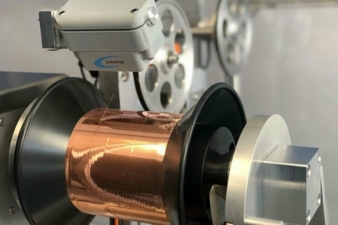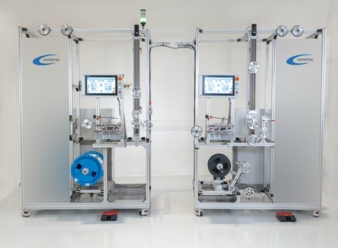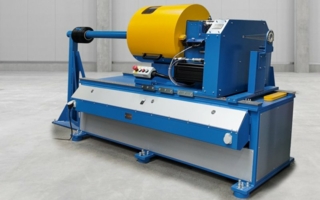24/10/2023 – Winding technology for the production and processing of fine wire or optical fibres
High-precision positioning and winding
Supertek sets new standards in winding technology for the production and processing of fine wire or optical fibres.
The ever-increasing technological demands on tension control and positioning accuracy are particularly evident in laser processing. An outstanding example is the demanding requirements for the embossing of “Fibre Bragg Gratings” (FBG) using laser beams in the manufacture of fibre-optic sensors. Very precise positioning of the optical fibres is of crucial importance here. For this demanding task, Supertek components and machines with their high-precision unwinders, capstans, belt haul-off, tension controllers, dancer accumulators, sensors and rewinders are the ideal solution.
The precise positioning of the fibre is ensured by the mechatronic integration of the winding modules with high-resolution electrical drive systems and the real-time controlled winding controller “MCU” from Supertek. With the active storage systems, the optical fibre can be kept in the necessary length, for example for imprinting the grating structures into the optical fibre. Bidirectional coil winding to an exact position is also possible using Supertek's winding technology.
For the positioning and synchronisation of the laser application, it is expedient to decouple the sub-processes unwind and rewind. The decoupling is realised by using the belt haul-offs in combination with the dancer and accumulator systems. In this constellation, a belt haul-off is used as the master for speed control and positioning. Supertek offers high-precision belt haul-offs with position steps from 10 µm for this purpose. The exact tension control is regulated by the electromagnetic dancer “EDL 60” or “DER 10” with iteration steps of 1mN. Thanks to the homogeneous dancer force based on the patented principle, the tension of the optical fibre always remains constant, even during dynamic processes such as "stop and go". The precise tension control ensures the processing of very thin and breakable optical fibres in the highest quality.
All processes are intelligently automated by Supertek's Industry 4.0 standards. The visualisation enables intuitive operation and observation of the entire machine processes. All parameters, such as the tension, positions or speeds, can be adjusted via the visualisation and saved in libraries. The high-precision processes are always reproducible. This enables the validation of new production methods for research and development purposes. For this reason, Supertek machines are not only used in production, but also for research applications.
Thanks to Supertek's extensive modular system, the machines can be assembled to suit specific applications and individual requirements. The modular system includes different and combinable winder models. This includes the “ED”, “MW” and “SW” class. The “ED” and “MW” class is equipped with a shaft for coil mounting. In contrast to the “ED” class, where the winding material is moved linearly during winding, the “MW” class enables a linear movement of the complete spool. This results in a straight material path during the entire production process, which ensures gentle processing of thin wires or fibres. Flat wires can also be wound in precisely defined layers with this principle.
The new “SW” class winders are shaftless and feature an innovative spool holder with automatic clamping unit for high-precision rotation. The complete system can move linearly so that the material, wire or fibre can also be unwound or wound in a straight line and orthogonally to the spool axis. The “SW” class can also be equipped with automatic threading and spool changing for fully automated production. With the “SW” class, the integration of an optical coupling for applications with optical fibres is also easily possible.
For orthogonal unwinding, it is necessary to measure the position of the wire or fibre. The “MPS” position scanner is suitable for this. The 3D coil scanner “TDS” is used for automated flange detection and controlled winding.
For the manufacture of medical products in the pharmaceutical and medical technology industries, Supertek also offers the components and machines for use in the clean room.
More information: www.winding-technology.com
The author is Gerd Janssen, managing director of Supertek GmbH.
Supertek GmbH
Nesserlander Straße 120
26723 Emden
Contact person is Gerd Jansen
Tel.: +49 4921 93690-11
gerd.janssen@supertek.de
www.supertek.de





